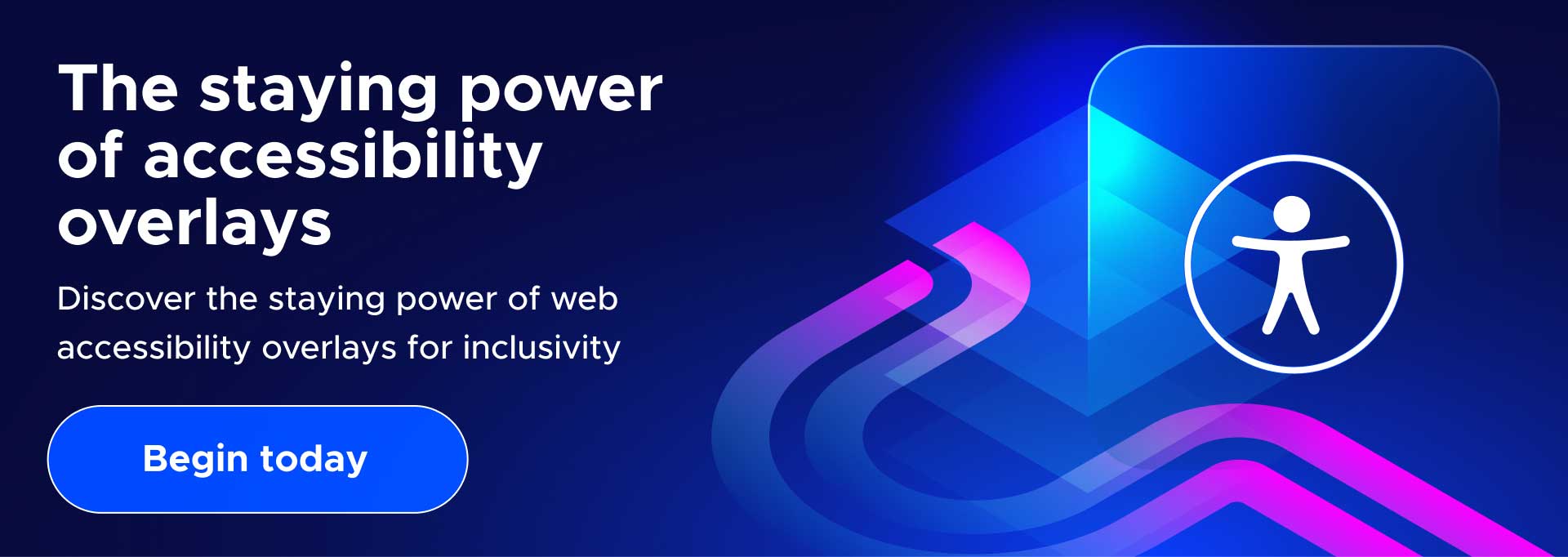Accessibility Overlays Are Here To Stay: Here’s Why

Website accessibility overlays are innovative solutions, revolutionizing accessibility. They are already helping millions of organizations make their websites more accessible for people with disabilities, and more compliant with federal and international regulations.
In today’s world, where websites and mobile apps now dominate user preferences, digital accessibility and universal web design has never been more critical. Nearly 26% of Americans live with a disability: that’s 1 in 4 people. A staggering one billion people are considered disabled worldwide.
That’s a significant demographic who should be able to use the internet and other digital assets just like everyone else. Accessibility overlays are helping make that happen.
How Do Accessibility Overlays Work?
An accessibility overlay (or accessibility widget) uses AI automation and machine learning to detect and sometimes fix digital accessibility barriers, improving usability for millions of people with visual, auditory, motor, and cognitive disabilities.
People have interacted with overlays without knowing it. An overlay is a standard interactive website feature that lays over a website design stack and can be used to provide additional information or executive actions, such as scrolling up a footer ad, or a button that can redirect a browser to the top of a webpage.
Real-Time Analysis & Management
Accessibility overlays provide website developers with support software as an alternative to cost-exorbitant and time-consuming exhaustive manual issue detection and remediation. Overlays can also analyze websites around the clock, detecting accessibility violations such as missing alt-text, heading tag issues, and empty links. Some overlays can recommend and even execute code-level remediations.
User-Facing Customizations
An accessibility overlay can also provide user-facing customization options. This enhances customer experience, and accommodates even hidden or invisible disabilities, as well as situational inconveniences. These customization changes include adjusting font size, orientation, contrast strength, and native screen-reader tools. These accessibility interfaces are typically available as buttons in the corner of websites, and use the universal accessibility symbol.
Why Web Accessibility Overlays Are Needed
Considering that most websites remain inaccessible to people with disabilities, accessibility overlays are becoming increasingly important. Millions of businesses and organizations currently rely on overlay software such as UserWay’s AI-Powered Accessibility Solution to help provide a diverse, inclusive, and equitable user experience for people with disabilities.
But will compliance overlay software ever compete with the thoroughness or quality of traditional testing and design? The short answer is yes, but it is worth exploring why. Let’s jump in.
Closing the Accessibility Gap
Accessibility overlays provide more affordable, faster, and sustainable professional-level capabilities compared to strictly manual testing and code fixes. These advantages are closing the “accessibility gap” that exists for websites that should be in compliance with the Web Content Accessibility Guidelines (WCAG) and the Americans with Disabilities Act (ADA).
This gap has widened in recent years, as large enterprises have been able to set aside large budgets for accessibility design. Meanwhile, in e-Commerce, sole proprietors, and small- and medium-sized businesses do not have the time, skill, or resources to dedicate to such projects.
Without overlay technology, many of these websites wouldn’t have any accessibility solutions at all.
Increasing the Number of Accessible Websites
Despite the ADA being in place for 30 years, according to a recent study by WebAIM, only 3% of the top 1 million websites are free of WCAG violations. This means the vast majority of internet experiences will present barriers for people with disabilities, preventing them from accessing information, communication, government services, and quality-of-life opportunities.
This also means millions of people with disabilities are being funneled into a small number of websites with elite accessibility design. Overlays make accessibility feasible for more websites, and allow them to remain competitive.
Helping to Mitigate Legal Liabilities
The legal landscape in accessibility alone reveals a massive need for better accessibility solutions.
Under the ADA’s Title III, it is illegal for public-facing businesses, such as restaurants, retail stores, banks, and event venues, to discriminate based on ability. When business and organization websites do not provide compliant web design and structure, they are at increased risk of regulatory fines, civil lawsuits, settlements, consent orders, and steep attorney fees.
Website-related lawsuits under the ADA have exploded over the past 10 years, growing from just 18 in 2014 to more than 4,000 in 2021. Websites using an accessibility overlay are 85% less likely to be sued, and fewer than 2% of UserWay’s customers ever face legal action.
Misinformation on Accessibility Overlays
There have been sharp criticisms of the use of website accessibility overlays in recent years. While some objections are raised in good faith, and challenge providers to create more robust products, many attacks are baseless.
Myth: All Accessibility Overlays are the Same
Most claims against overlays are precisely that: overlays in the plural. They do not take into consideration that in the digital marketplace, there are various accessibility products that provide a range of different services. Some overlays are excellent and extremely helpful; some are fair-to-middling; and some are flat-out barriers rather than helpful. However, rather than judging each overlay on its own terms, overlays are spoken of in general, as a blanket condemnation.
These allegations are too simplistic and not factually accurate. Digital accessibility software is a dynamic industry, and overlays differ in quality and comprehensiveness depending on many factors.
Myth: Automated Solutions Hurt Accessibility
A common accusation against accessibility overlay products is that because they are automated, they can never truly account for the challenges people with disabilities face with usability, and AI remediations are not good enough to reach full regulatory standards.
Smart overlay technology, like UserWay’s AI-Powered Solution, punches above its weight and continues to be the leading example of automated remediation technology done right. Many of UserWay’s automated remediations are subject to a manual approval process to ensure fixes are done correctly and within context.
AI solutions are being upgraded and sharpened every day. While issues and false negatives may be a concern in an automated process, this criticism is predicated on the position that human accessibility designers are not prone to the same mistakes, which is not true. The best designers in the industry make mistakes and overlook violations, even on their own websites.
Myth: Overlays Impact Loading Speed
Some argue that overlays reduce the loading speed of websites. In UserWay’s case, that simply isn’t true. UserWay’s accessibility widget only makes modifications after a website has loaded so that it doesn’t affect load time.
Myth: Only Accessible When Triggered
One claims states overlays require a user to self-activate an overlay before a website becomes accessible, which can be problematic if the user is not able to find or activate it. However, robust accessibility overlay products help detect violations and make accurate remediations at the code level, so the standard website has many accessibility improvements completed by automation even before user accessibility preferences are toggled.
Fact: UserWay’s AI-Powered Accessibility Solution is the Leading Accessibility Overlay Product
In UserWay’s case, the AI is significantly more accurate and advanced, providing much more detailed descriptions for image alt-text. That includes full sentences and correct grammar, instead of just using keywords.
An accessible internet is a long-term journey, and as technology changes and improves, UserWay intends to be ahead of the curve to serve the accessibility community best.
The Road Ahead: Faster, Better, More Accessible
While there is much to be said for an artisanal approach to accessibility, there’s no reason even the most skilled expert cannot utilize automated tools to gather information. What’s perhaps not immediately apparent is that the input of testing experts is also fed back into the UserWay AI-Powered Solution to share accessibility fixes with all users, and this is ongoing.
So, for example, if a new accessibility bug pops up and is remediated, it can also be added to a checklist that will automatically be taken care of. And that’s not a small benefit. Automated Human-in-the-Loop technology is the best tool we currently have. It seems reasonable to use the most effective tools at our disposal.
Frequently Asked Questions
What is an Accessibility Overlay?
An accessibility overlay is a software tool used to make websites more accessible to people with disabilities. It typically consists of a layer that is overlaid on top of a website stack and provides a variety of options and features that can be used to customize the way the content is displayed and interacted with. This included detecting and fixing accessibility violations as well as user tools such as text to speech, screen magnification, color contrast adjustment, and more.
Are Accessibility Overlays Worth It?
Accessibility overlays are making significant improvements in both the affordability and efficiency of accessibility services. Accessibility software provides low-cost solutions for continual scanning for violations on websites, continual monitoring to account for new content, and professional and code-level remediations. Not only is the cost of an accessibility overlay a fraction of traditional accessibility services, but they also provide enhanced business benefits and liability protection.
Will an Accessibility Overlay Get Me Sued?
Website-related lawsuits under the Americans with Disabilities Act (ADA) have surged in the past 10 years, going from just 18 in 2014 to more than 4,000 in 2021. The claim that using an accessibility overlay or service provider will directly result in a lawsuit is a fallacy and fails to acknowledge that more than 75 percent of those subject to web accessibility lawsuits are not using an accessibility overlay.
Less than 2% of UserWay’s pro-widget users are ever subject to a web accessibility lawsuit. Even in those cases, all paid UserWay customers have access to a premium legal support program which provides guidance in addressing and responding to any type of legal complaint.





Share